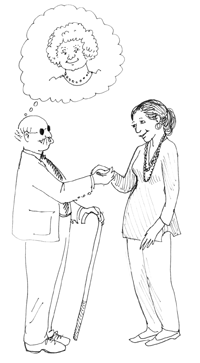STRANGE BUT TRUE- Blind images: They'll see you in their dreams

DRAWING BY DEBORAH DERR McCLINTOCK
Q. Do the blind picture the people they meet but have never seen? –Homer
A. It is well-established that people who lose their sight through disease or accident after ages 5 to 7 continue to conjure up visual images of familiar people, things and events, says University of California psychologist G. William Domhoff in The Scientific Study of Dreams. They also continue to "see" in their dreams, and amazingly, form visual dream images of people they met after becoming blind! This supports the idea that the blind have a system of imagery independent of any perceptual capabilities. "On the other hand, people who become blind before ages 5 to 7 do not have waking visual imagery or visual dreams," Domhoff says.
Among the congenitally blind, a high percentage of their dreams have sound, taste, smell or touch, and similar to sighted dreamers, a story line. One thematic difference, though, is a concern about locomotion/transportation, such as one blind dreamer finding himself on hands and knees with ear to the ground listening for traffic at a crosswalk, and a woman who dreamed about getting lost with her guide dog.
Q. What other species have benefitted most from Viagra, that marital wonder drug brought to us courtesy of Dr. NO? –D. Juan
A. Dr. NO is nitric oxide (NO) which regulates bodily activities from head to toes– brain, nose, throat, lungs, stomach, kidneys, blood vessels all need it, says John Emsley in Vanity, Vitality, and Virility. Our body generates a constant supply of NO molecules, but none last more than a few seconds. It turns out that erotic thoughts will boost NO, with predictable results. Then an enzyme works to counter the NO, and in some men, especially older men, the counterer goes too far. Result: Problems.
In the late 1980s a team working to treat angina discovered that the drug sildenafil citrate can counter the counterer, bringing on marital health again. Viagra was launched, with more than 35,000 prescriptions written in the first week, 5 million by year's end.
Side effects? Sure, says Emsley. But one curious effect of the "Viagra Niagara" turned out not negative at all, at least regarding certain African rhinoceroses and harp seals. The rhino had been facing extinction, its keratin-containing horn rumored in Chinese medicine to make a potent anti-impotency drug. "Now Chinese men take Viagra instead... With a bit of luck, rhinos (and harp seals for allied reasons) will now not join the list of extinct mammals."
Q. Go outside on a clear day and peer with one eye through a long cardboard tube (as for paper toweling) at the lovely blue sky, keeping the other eye open. Guess what's going to happen to the color. –B. Franklin
A. Within a few seconds the small disk in the tube will start to lose its blueness, becoming whiter and whiter, while the other eye continues to see the original color, says Peter Pesic in Sky in a Bottle. One 19th-century observer regarded this bleaching as proof the sky's blue is an optical illusion. But the same "bleaching" of your retinal receptors will occur when you stare at any uniform blue field of view, such as a bright blue cloth. Likely this is a cortical phenomenon relating to the lack of information, e.g., contours and texture, in the signal, says University of Southern California psychologist Ernest Greene.
"Habituation" occurs as the brain in a sense "turns off" to the lackluster visual event.
Q. I've been baffled by this for years: I have brown eyes with a touch of green. They appear dark brown in the daytime but in the evening or in dim light, they appear very green, almost grey. Why is this? –J. Martin
A. The answer lies in our eyes' sensitivity to the different parts of the spectrum at different light levels, says Berkeley optometrist and vision scientist Dr. Gunilla Haegerstrom-Portnoy. By day, we are most sensitive to yellow, brightest region of the spectrum; you can think of "brown" as dark yellow, therefore a day-sensitive hue. So during the day the eyes have both apparent yellow and green in them.
At night or in dim light, our eyes are more sensitive to the green component, and so the apparent color shifts to green. In very low light, we lose all ability to detect color and everything appears as shades of grey, because we switch from seeing with our retinal cones to retinal rods alone. "This shift of apparent brightness of colors is called the Purkinje shift, described in the early 1800s by Hungarian physiologist Johannes Evangelista Purkinje (eye color unknown)."
Hence the answer to the mystery lies less in the chameleon eyes than in the skies and the changes in the ambient light emanating therefrom throughout the day.
Q. What mighty big number got named by a little kid? –B. Gates
A. When mathematicians Edward Kasner and James Newman introduced the "googol," the word caught on, says Isaac Asimov in On Numbers. "Personally, I think it's an awful name, but the 9-year-old nephew of one of them invented it, and what could a proud uncle do?" says Asimov.
A googol's the number 1 followed by 100 zeros, or ten duotrigintillion in American nomenclature. Even national economies are beggared by such a count: the U.S. gross national product is around $10 trillion, or only 13 zeros. Add another zero and that's roughly the global economic output– whereas 100 zeros goes well beyond the number of atoms in the universe!
Send Strange questions to brothers Bill and Rich at [email protected].
#